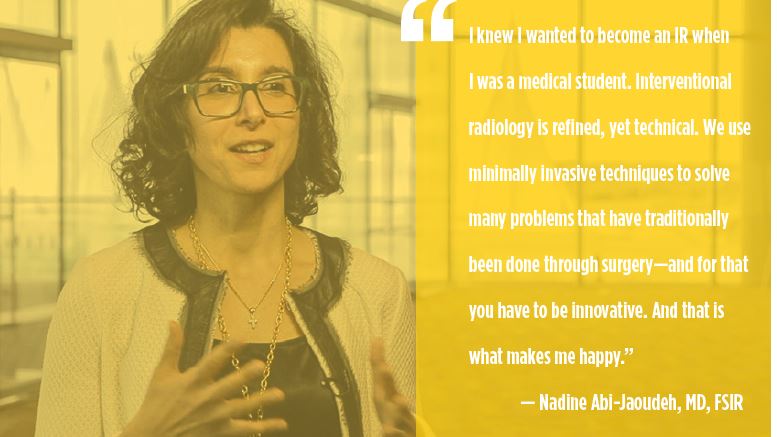I AM IR
How has interventional radiology become the most exciting specialty in medicine today? By fostering creativity and innovation in a collaborative environment where clinical and research professionals freely exchange ideas to find inspired solutions to patient care. Cancer, stroke, venous disease, peripheral vascular disease and trauma are just a few of the conditions that IRs treat using innovative techniques and creative problem-solving skills. The limitless potential of image-guided medicine to solve the toughest medical problems and improve patient outcomes is inspiring.
Inspired. Realizable.
Interventional radiology is a collaborative, technology-driven specialty focused on turning ideas into reality to improve patient quality of life. With our colleagues in research, physicians from other disciplines and industry supporters, IR is advancing medical practice and collaborative relationships that benefit everyone.
IRs use X-rays, MRI and other imaging to treat the disease at its source. These techniques allow IRs to treat conditions that once required surgery—less invasive with less risk, less pain and less recovery time compared to open surgery. And often with less cost.


Interventional radiologists are board-certified physicians who specialize in minimally invasive, targeted treatments. IRs are visionaries, whether they are researching new techniques or directly caring for patients.
The board certification, administered by the American Board of Radiology, includes both vascular and interventional radiology and diagnostic radiology. Always curious, IRs collaborate with colleagues from multiple disciplines to understand the patient’s unique needs to develop a treatment plan that will improve the outcome. To do this, IRs must not only possess in-depth knowledge of the least invasive treatments available, they must understand these other disciplines and treatments.
Are you ready to pursue an IR specialty?
In 2012, the American Board of Medical Specialties (ABMS) approved interventional radiology as a primary specialty in medicine, which led to the development of the IR Residency. Components of the residency include diagnostic imaging, image-guided procedural technique and clinical care. More than 60 programs have received accreditation for their integrated IR residency, with many more in process. The integrated IR residency, independent IR residency and Early Specialization in IR (ESIR) represent the various formats of the IR Residency. The traditional pathway of 4 years of a diagnostic radiology residency, plus an additional year of IR fellowship, will continue until June 30, 2020. All accredited training in interventional radiology will occur in the IR Residency programs beginning July 1, 2020.

Erika Ugianskis, MD, an interventional radiologist at Indiana University Health Arnett Hospital in Lafayette, Indiana, talked to us about being an interventional radiologist.